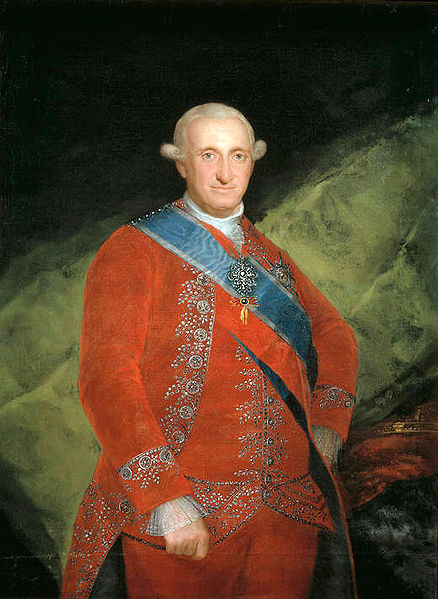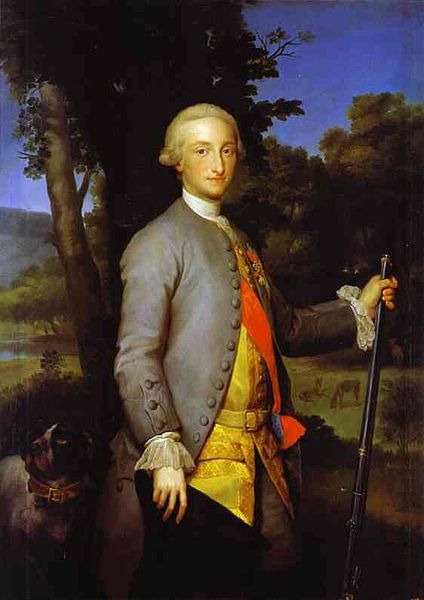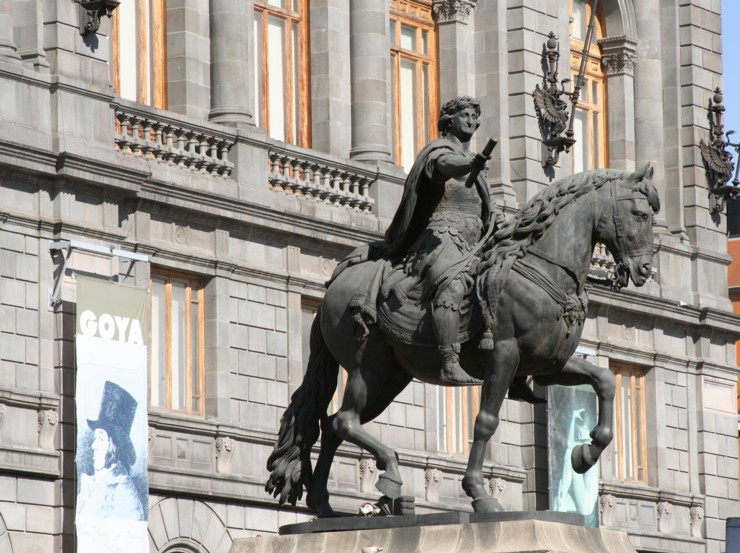<Back to Index>
- Mathematician John Henry Constantine Whitehead, 1904
- Painter Jean Édouard Vuillard, 1868
- King of Spain Charles IV, 1748
PAGE SPONSOR


Charles IV (Carlos Antonio Pascual Francisco Javier Juan Nepomuceno Jose Januario Serafin Diego; 11 November 1748 – 20 January 1819) was King of Spain from 14 December 1788 until his abdication on 19 March 1808.
Charles was the second son of Charles III and his wife Maria Amalia of Saxony. He was born at Portici, while his father was king of the Two Sicilies. His elder brother Don Felipe was passed over for the two thrones as mentally retarded and epileptic. In Naples and Sicily he was styled as the Prince of Taranto.
Charles had inherited a great frame and immense physical strength from the Saxon line of his mother, granddaughter of August the Strong. When young he was fond of wrestling with the strongest countrymen he could find. While he was considered by many to be intellectually sluggish and quite credulous he was also known for his acts of kindness.
In
1788, Charles III died and Charles IV succeeded to the throne. Even
though he had a profound belief in the sanctity of his office and kept
up the appearance of an absolute, powerful monarch, he never took more
than a passive part in the direction of his own government, occupying
himself with hunting. The affairs of government he left to his wife and his prime minister. In 1792, Maria Luisa finally succeeded in ousting the Count of Floridablanca from office and had him replaced with Pedro Pablo Abarca de Bolea, Count of Aranda, the chief of the Aragonese party. However, in the wake of the war against Republican France, the liberal leaning Count of Aranda was replaced by Manuel de Godoy, a favourite of the Queen and allegedly her lover, who thenceforth enjoyed the lasting favour of the King. Godoy continued Aranda's policy of neutrality towards France but after Spain protested against the execution of the deposed king in
1793, France declared war on Spain. After the declaration of war
against Spain, Portugal and Spain signed a treaty of mutual protection
against France. In 1795 France forced Godoy to conclude an alliance and declare war on the Kingdom of Great Britain. In 1803, after smallpox had affected his daughter María Luísa, the king commissioned his doctor Francisco Javier de Balmis to bring the vaccine to the Spanish colonies on state expenses. Spain remained an ally of France and supported the Continental Blockade until the British naval victory at Trafalgar. However, after Napoleon's victory over Prussia in
1807, Godoy again steered Spain back onto the French side. This
switching back and forth devalued Charles' position as a trustworthy
ally while the return to the French alliance increased Godoy's
unpopularity and strengthened the partido fernandista, the supporters of Crown Prince Ferdinand, who favoured a close relationship with the United Kingdom. When King Charles was told that his son Ferdinand was appealing to Napoleon against Godoy, he took the side of the minister. When the populace rose at Aranjuez in 1808 he abdicated on 19 March, in favour of his son, to
save the minister who had been taken prisoner. Ferdinand took the
throne as Ferdinand VII, but was mistrusted by Napoleon who had 100,000
soldiers in Spain by that time. Charles
IV found refuge in France, and became a prisoner of Napoleon: the
latter, posing as arbiter, summoned both Charles IV and his son to Bayonne in
April and coaxed Charles (who had a difficult time restraining himself
from assaulting his son) to retract his earlier abdication and
abdicate, on 5 May 1808, in favour of Napoleon. Napoleon then made his brother Joseph Bonaparte king in Spain. Charles was then interned in Talleyrand's castle in Valençay. He accepted a pension from the French Emperor and spent the rest of his life between his wife and Godoy, staying briefly in Compiègne and longer in Marseille. In 1812, he finally settled in Rome in the Palazzo Barberini. His
wife, the former Queen, died on 2 January 1819. He died, reportedly of
overwhelming despair and heartbreak because of the death of his wife,
on 20 January 1819. Charles IV married his first cousin Maria Louisa, the daughter of Philip, Duke of Parma, in 1765. The couple had fourteen children, six of whom survived into adulthood. Maria
Luisa was widely considered a vicious and coarse woman who thoroughly
dominated the king. During the lifetime of Charles III, she led her
husband into court intrigues against the prime minister, the Count of Floridablanca.
